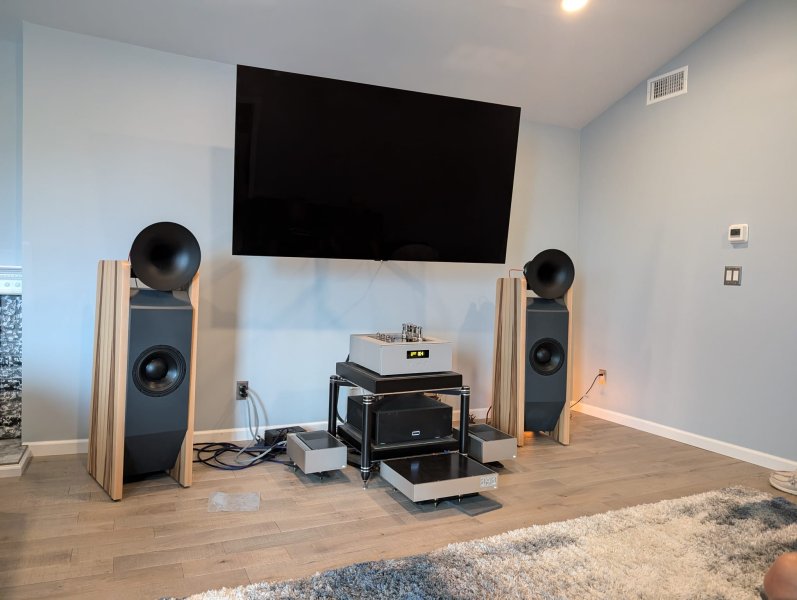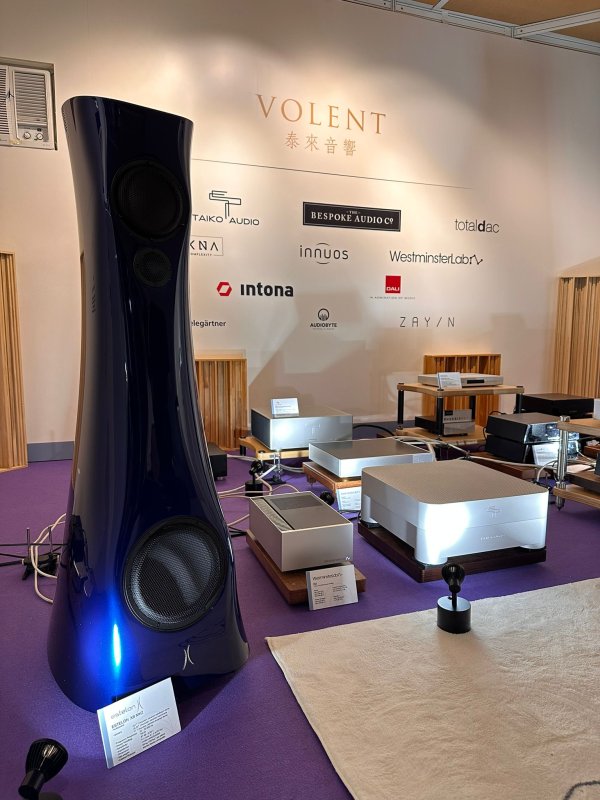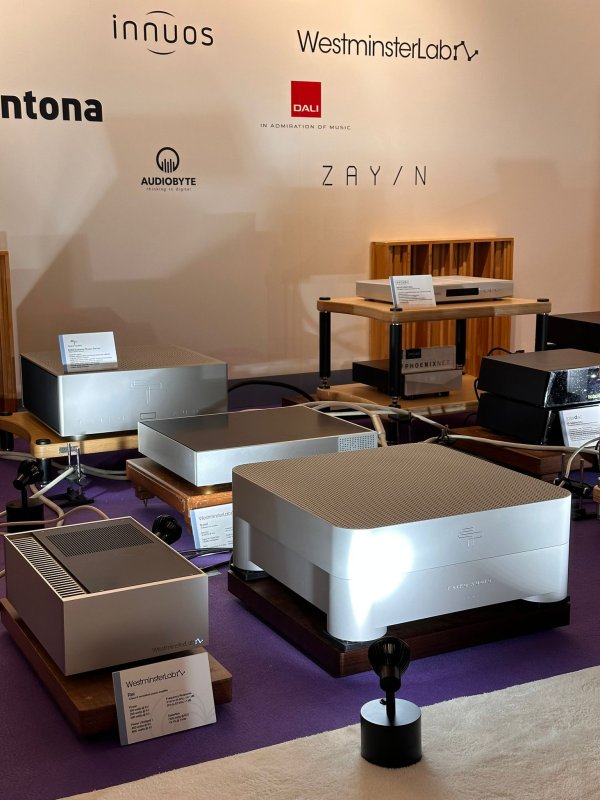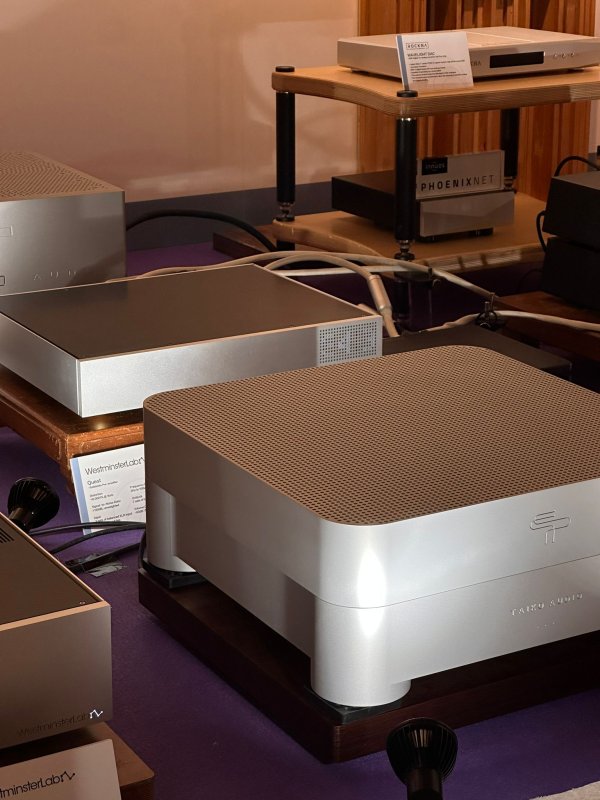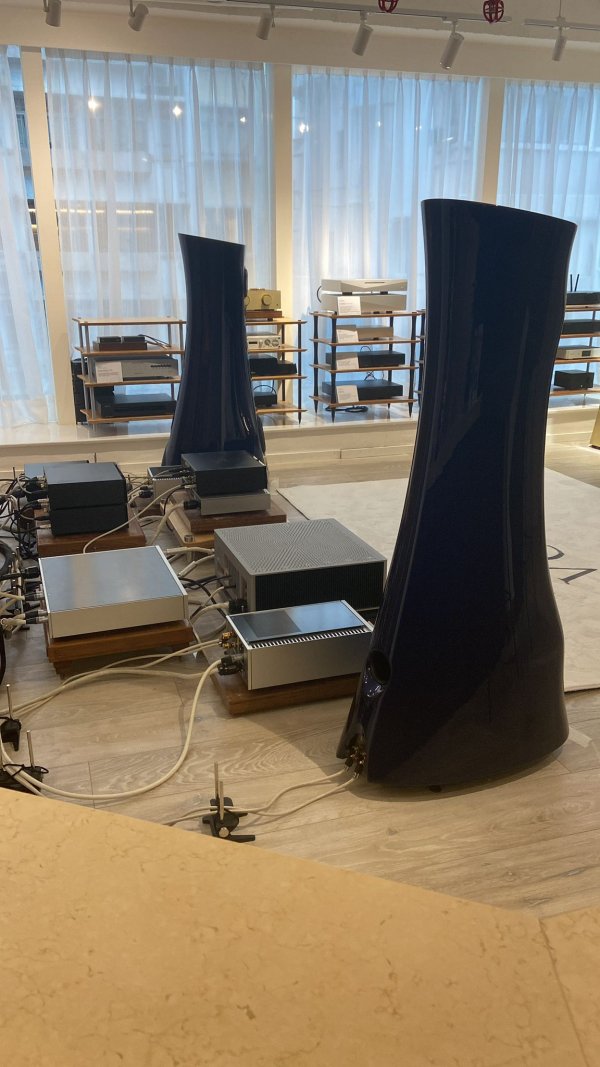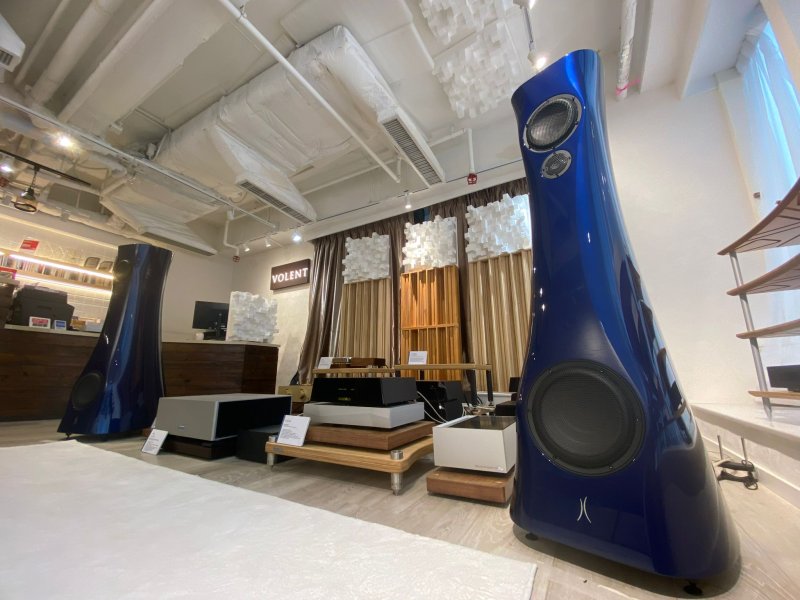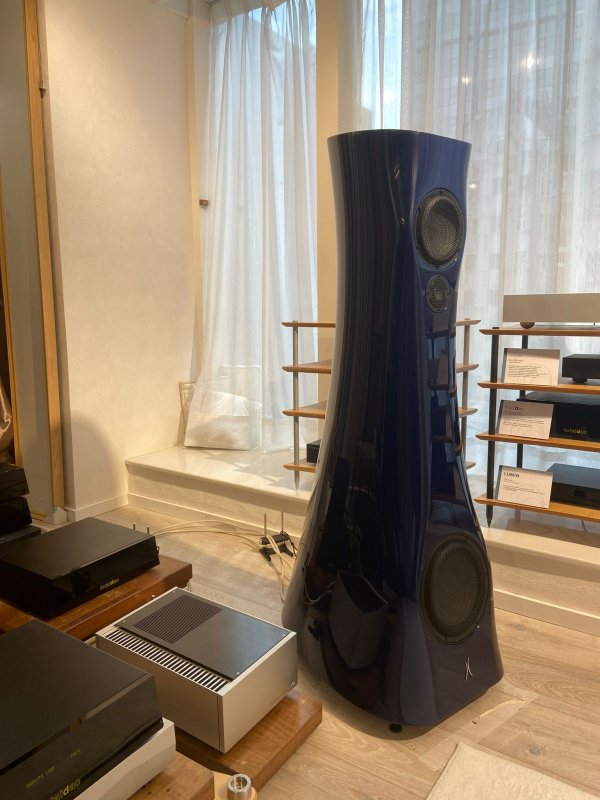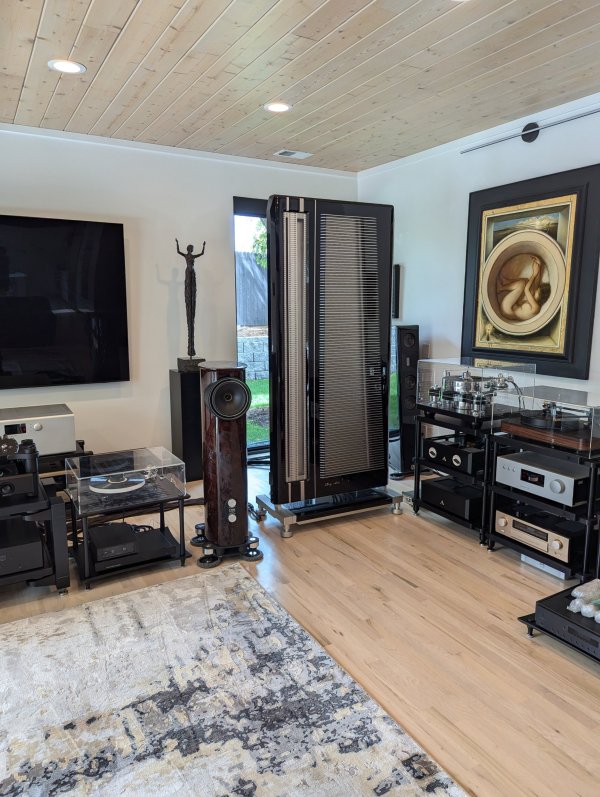WestminsterLab Re-imagining Amplification
- Thread starter gleeds
- Start date
You are using an out of date browser. It may not display this or other websites correctly.
You should upgrade or use an alternative browser.
You should upgrade or use an alternative browser.
Rob, I love the simplicity of your system. I can't wait to listen at Chez Rob this fall. It's been too long since I've been back to the Big Apple.That would be a great option. We've spent many hours listening to the REIs driven directly by the Lampi Poseidon in one of our demo systems here on Long Island, NY and it is a simple and fantastic combination.
View attachment 134396
Good afternoon, everyone. Angus sent photos of the WestminsterLab Rei amplifiers and Quest preamplifier powering large Estelons along with the mighty Taiko Olympus at the Hong Kong Audio Show. As far as I know, this is the first public showing of this intriguing new product!
Attachments
Hopefully soon Rob, Fred @LampiNA and myself way behind at #102, as well as I am sure many others here will have the same combo albeit with different speakersGood afternoon, everyone. Angus sent photos of the WestminsterLab Rei amplifiers and Quest preamplifier powering large Estelons along with the mighty Taiko Olympus at the Hong Kong Audio Show. As far as I know, this is the first public showing of this intriguing new product!
Since I hear good things about the Olympus onboard DAC, WestminsterLab offers a single-ended RCA card for the Quest balanced preamplifier. That said, we exhibited at the SF Bay Area Audio show; with the Horizon DAC in use, I have never heard better with our electronics. I'll watch how the bar moves once the Lampizator/Olympus interface is implemented. Kudos to Lukaz for aggressively pursuing this and being the first to offer it!
Last edited:
Yes, the Rei were even smaller (size-wise) than I had imagined, but the sound was anything but small. Kudos to the Westminster Lab team !Good afternoon, everyone. Angus sent photos of the WestminsterLab Rei amplifiers and Quest preamplifier powering large Estelons along with the mighty Taiko Olympus at the Hong Kong Audio Show. As far as I know, this is the first public showing of this intriguing new product!
It was a great show and thank you Gary for posting the picture. I've work with Ben ( From Volent Audio ) for many years and it was a beautiful setup he had put together at the show. The Olympus DAC is really something interesting ( the unit was brand new, so I will need a bit more listening to give my verdict )!Since I hear good things about the Olympus onboard DAC, WestminsterLab offers a single-ended RCA card for the Quest balanced preamplifier. That said, we exhibited at the SF Bay Area Audio show; with the Horizon DAC in use, I have never heard better with our electronics. I'll watch how the bar moves once the Lampizator/Olympus interface is implemented. Kudos to Lukaz for aggressively pursuing this and being the first to offer it!
Angus Volent does a great job and has a beautiful showroom in HK. I am excited to visit before the year is out. Of course, when you listen more, make sure to compare the Olympus not only to other front ends but also to your superb vinyl rig!
Attachments
It's panel time!
Recently, I have had fun experiences with Reis powering Clarisys and Alysvox. You will ask which I like better, so I will dodge a bullet and honestly say I like both.
The Clarisys Studio + is incredible value for money. It does not play as big as the Auditoriums but retains all its essential qualities. The Piccolos remains one of the best values in high-end audio.
The Botticellis with external crossovers are refined and easy to get lost in. Auditoriums scale better for significant orchestral works, electronic music, etc.
Both Clarisys and Alysvox play incredibly well with Westminsterlab. Powering Ron's Studio + with a single pair of Rei is no problem!
It's a good time to be a panel lover. Next, I'll hear the Diptuques powered by Reis, albeit I do not expect them to match the speed and transparency of the ribbons. We will see
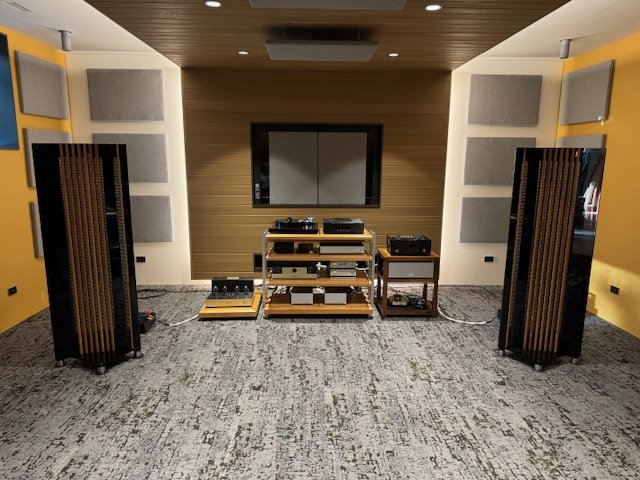


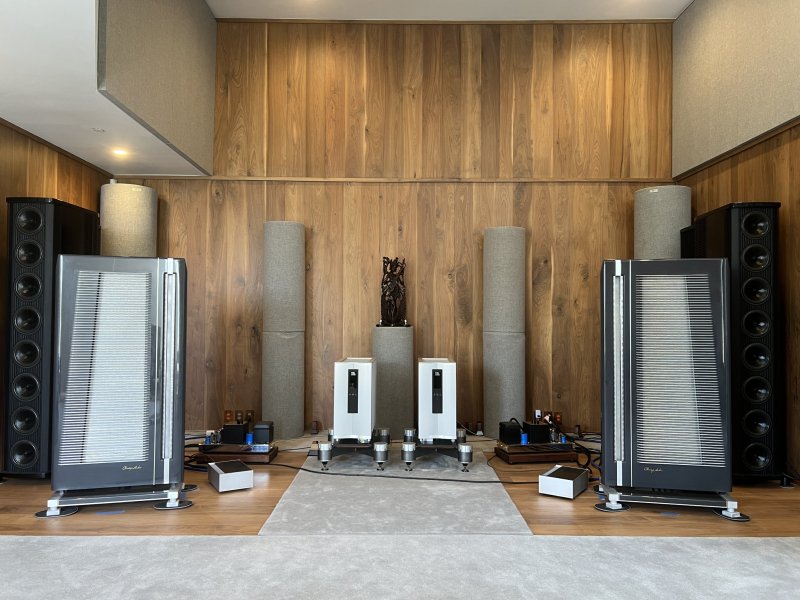
Recently, I have had fun experiences with Reis powering Clarisys and Alysvox. You will ask which I like better, so I will dodge a bullet and honestly say I like both.
The Clarisys Studio + is incredible value for money. It does not play as big as the Auditoriums but retains all its essential qualities. The Piccolos remains one of the best values in high-end audio.
The Botticellis with external crossovers are refined and easy to get lost in. Auditoriums scale better for significant orchestral works, electronic music, etc.
Both Clarisys and Alysvox play incredibly well with Westminsterlab. Powering Ron's Studio + with a single pair of Rei is no problem!
It's a good time to be a panel lover. Next, I'll hear the Diptuques powered by Reis, albeit I do not expect them to match the speed and transparency of the ribbons. We will see




Attachments
Last edited:
I have installed the Westminster Labs Ultra XLR ICs between the Poseidon and the REIs with a Paradox Pulse "digital" SPDIF cable to the Jay's Audio CDt3 Mk3 transport into Von Schwiekert VR9 SE Mk2 upgraded. I am now enjoying the out of the box sound of 1000s of well recorded music CDs that I experienced with the Von Schweikert Ultra 9 and 11 speakers at two shows. Astounding and so great that it rivals my best analog. I force myself to go to bed after listening for 2 to 4 hours nightly. The performers are often in front of me (with percussion accompaniment similarly located to the rear and center in early stereo recordings). Thrilling yet relaxed at a very wide range of volume settings, maintaining both dynamic contrasts and the full tone/body of the instruments/singers. It's relaxed as there the music sounds like it's being performed in front of me. Not in a large room (20X15X10-although of custom built quality). The money spent on matching cables is worth the result.
I'm extremely satisfied with my choices with the expert assistance of Gary Leeds.
I'm extremely satisfied with my choices with the expert assistance of Gary Leeds.
Thank you for the kudos, Stephen. Receiving messages like this has been the pleasure of my involvement and career in audio. Keep listening and enjoying always!I have installed the Westminster Labs Ultra XLR ICs between the Poseidon and the REIs with a Paradox Pulse "digital" SPDIF cable to the Jay's Audio CDt3 Mk3 transport into Von Schwiekert VR9 SE Mk2 upgraded. I am now enjoying the out of the box sound of 1000s of well recorded music CDs that I experienced with the Von Schweikert Ultra 9 and 11 speakers at two shows. Astounding and so great that it rivals my best analog. I force myself to go to bed after listening for 2 to 4 hours nightly. The performers are often in front of me (with percussion accompaniment similarly located to the rear and center in early stereo recordings). Thrilling yet relaxed at a very wide range of volume settings, maintaining both dynamic contrasts and the full tone/body of the instruments/singers. It's relaxed as there the music sounds like it's being performed in front of me. Not in a large room (20X15X10-although of custom built quality). The money spent on matching cables is worth the result.
I'm extremely satisfied with my choices with the expert assistance of Gary Leeds.
Listening notes – Westminster Quest Preamplifier v2
This report has been a while in the making. A few months ago, thanks to Fred @LampiNA and Gary, I purchased a Westminster Quest (the updated version 2) preamplifier to partner with the REI monoblocks which I and others have raved about on these pages.
I should preface this with the caveat that adding an active preamplifier is somewhat of a departure from my longstanding philosophy of simplicity and eliminating a preamp for increased transparency. For a long time I was running my Lampizator Big 7 / Golden Gate / GG2 / Pacific / Horizon through a passive attenuator or buffered passive preamp, which ranged from the Placette to the very well regarded Townshend Allegri, to Art Salvatore’s fave, the Hornshoppe “The Truth”. With the Lampi Horizon, I took things a step further and eliminated even the passive preamplifiers/attenuators, and ran the signal direct via 30’ lengths of XLR cable to the Westminsterlab REI monoblocks.
This was an extremely satisfying combination which brought musicality, rhythm and soundstaging in spades. Many on this forum have also done similar comparisons with the Horizon for “amp direct” vs “through a preamp” with results that were very close. So understandably I was a bit hesitant about what the Quest would bring to the table.
Earlier this year, I got wind of an amazing and highly effective upgrade that our resident genius @lscangus had come up with to further improve the already stellar Quest preamp. This finally induced me to take the jump into active preamplification.
Before the Quest arrived, I had arranged for my electrician to add another dedicated 10 gauge circuit to the audio subpanel in the garage below the music room for the Quest. The REIs and Quest v2 would be on their own circuits, as are the Taiko Extreme and Lampizator Horizon, with 10/2 MC solid core copper lines measured to be the same length for ground potential to the subpanel, which was a specially prepped Square D industrial unit from Kingrex.
Unpacking the Quest was again to marvel at the superb lines and elegant minimalist design clearly showing Angus’ architectural pedigree. The fit and finish is exacting and jewel-box like, similar to the REI monoblocks.
Placing the Quest into my system brought me to my first quandary. Given the 30+ foot distance between my source components and the speakers/amps, should I place the Quest right next to the source components, or as close as possible to the REIs?
Reading the manual indicates that the Quest should be placed as close as possible to the source components. Having the Horizon’s very high level output drive and the long run of cabling between source rack and amps could change things, however…
I decided to experiment with placing the Quest in both locations (close to source vs close to amps). I also experimented with the ground switch in position 1 (to right) vs position 2 (to left).
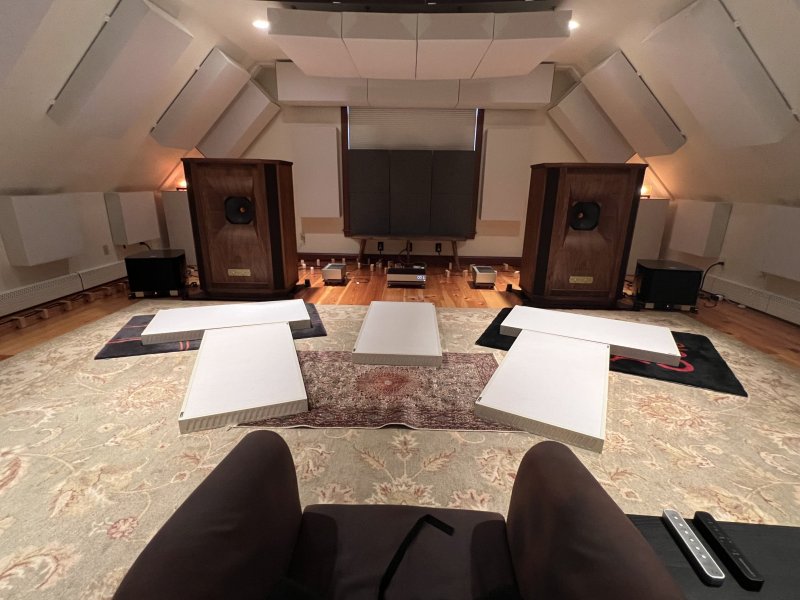

Listening Impressions:
I was unprepared for the big changes that the Quest v2 brought to my system. The best way I can describe this is the analogy of a fractal pattern. The broad outlines, PRaT, and macrodynamics were similar to having the Horizon direct, but there was now an explosion of inner detail fleshing out the waveform, all of which was delivered in a non-fatiguing and extremely natural fashion. Soundstaging was markedly improved and more stable/solid than before, but I believe this is a side effect of the increased resolution. The upper registers were slightly more brilliant compared to before, likely also related to the improved detail rendering, but never, ever fatiguing. Emotionality and involvement, previously already the best I’ve obtained from my system, were either preserved or on many recordings modestly improved.
This effect of a “detail explosion” was present with the Quest positioned either close to the source or close to the amps, but was more conspicuous with the Quest close to the amps. Perhaps having the high level signal of the Horizon driving my 30’ XLR interconnects before attenuating closer to the amps contributed. After a few A/B comparisons I settled on having the Quest next to the REI monoblocks. Testing the ground switch in #1 (standard, to right) vs #2 (alternate, to left) yielded a small but consistent preference to the #2 (alternate, to left) position which resulted in better involvement. Longer term listening tests below were conducted with the switch in the #2 position.
Wagner – Das Rheingold; Janowski, Konieczny, Elsner, Vermillion. Pentatone
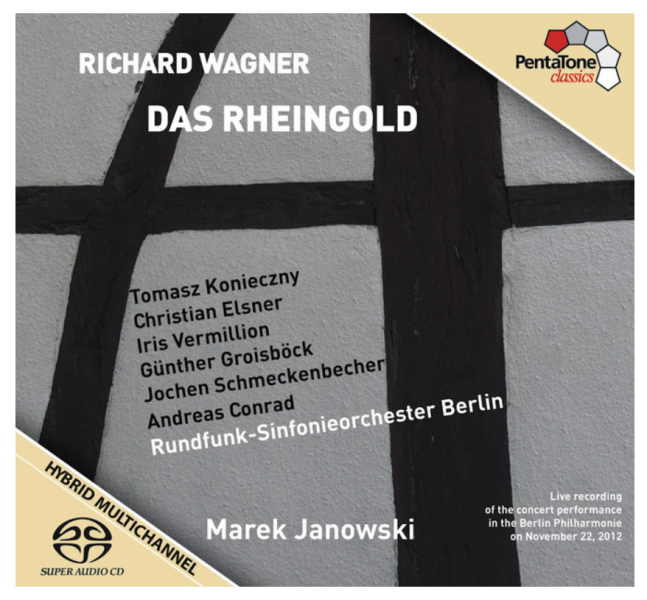
The addition of the Quest to my system was über-obvious in the first scene of the first opera in the Ring cycle. On this recording, before the introduction of the Quest, Wagner’s sweeping orchestration and beautiful vocal lines are gorgeous and emotionally exhilarating through the Horizon to the REIs – but – it took a bit of mental effort to disentangle the vocal lines of Woglinde, Wellgunde and Flosshilde (the 3 Rhinemaidens); soprano, mezzo-soprano and contralto. With the Quest in place – it was plainly obvious without any concentration that these were distinct and separate singers. Something about the enhanced low level detail retrieval of the Quest fleshed out the microvibrations for each singer’s voice; they are arrayed stage left and clearly resolved, while preserving and enhancing the overall beauty and emotional involvement of this scene at the beginning of Wagner’s largest work.
Verdi – Falstaff; Abbado, Terfel, Pieczonka, Hampson. Deutsche Grammophon

With the addition of the Quest, there was likewise a notable improvement in microdetail and soundstaging throughout this opera, with the macrodynamic sweeps and rhythmic drive of the Horizon and REIs completely preserved. In Act 1, Part 2, with “Alice – Meg – Nanetta” where similar to the opening scene in Das Rheingold, we have a soprano, mezzo-soprano, contralto and second soprano (Alice Ford/Meg Page/Mistress Quickly/Nanetta) exchanging lines in quick succession.
Once again, with the Quest in place, the different vocal lines just become obvious like they have been highlighted in different colors. It’s a pretty impressive demonstration of how the added microdetail from the Quest changes the nature of playback in my system, while never disturbing all the strengths of my system.
Vasks – Presence; Sol Gabetta, Amsterdam Sinfonietta. Sony

On this recording of Peteris Vasks’ “Klatbutne” the first movement is a test of the noise levels in my system. The first pizzicato notes emerge out of nowhere, like a primordial chirp. With the Quest, the blackness of the background is even more intensely black, but the microdetail brings out the background ambience like “quantum foam” in the vacuum of space.
Initially, I had a comparison planned to live music to test the Quest’s capabilities. We had Christina and Michelle Naughton, an acclaimed piano duo, and Gaia Wilmer/Jaques Morelenbaum with their band, play live in Orono, Maine at the University of Maine performance space. Jaques’ cello playing over the years has had frequent rotations on XDMS and Roon, especially as part of the Quarteto Jobim Morelenbaum and with Ryuichi Sakamoto. I took seats in the 2nd row from the performers, roughly 15-20’ from them.
I soon realized that due to the relatively suboptimal acoustics at the hall where they were playing, the comparison was laughable – the sound of their recordings in my listening room was miles ahead of how they sounded live. The acoustic deficits in the recital hall, where there was minimal acoustic treatment, resulted in overpowering bass from the drums and poor definition of the amazing woodwind playing from Maiara Moraes, Yulia Musayelyan and Oran Etkin, probably due to an excessively high RT60/reverberation time in the recital hall.
Regardless, aside from the energy of having true, real life performers in front of us, the sonic quality from the recordings Trem das Cores by Gaia Wilmer and Visions/American Postcard by the Naughton sisters was in a completely different league played through the Horizon/Quest/REI that I gave up any pretence of serious comparison.
Conclusions
In conclusion, the Westminsterlab Quest v2 was a remarkable addition to my system. Not only did it preserve and even burnish the emotionality and flow I loved best about my existing system, the Quest provided markedly increased transparency and microdetail, which was something I would have believed impossible within my old philosophy of less = better in the signal chain. The “explosion” of inner microdetail is hard to fully encompass, but I’ve given some notable examples above with female vocals that were quite pleasantly surprising to me. All this is delivered without fatigue or strain, with a smoothness and refinement that I wish I saw more of in the world of high end audio. To do this without impacting the pre-existing balance and qualities of my finely tuned/voiced system on the "macro" level is even more impressive. A spectacular achievement by Angus @lscangus once again, hats off.
This report has been a while in the making. A few months ago, thanks to Fred @LampiNA and Gary, I purchased a Westminster Quest (the updated version 2) preamplifier to partner with the REI monoblocks which I and others have raved about on these pages.
I should preface this with the caveat that adding an active preamplifier is somewhat of a departure from my longstanding philosophy of simplicity and eliminating a preamp for increased transparency. For a long time I was running my Lampizator Big 7 / Golden Gate / GG2 / Pacific / Horizon through a passive attenuator or buffered passive preamp, which ranged from the Placette to the very well regarded Townshend Allegri, to Art Salvatore’s fave, the Hornshoppe “The Truth”. With the Lampi Horizon, I took things a step further and eliminated even the passive preamplifiers/attenuators, and ran the signal direct via 30’ lengths of XLR cable to the Westminsterlab REI monoblocks.
This was an extremely satisfying combination which brought musicality, rhythm and soundstaging in spades. Many on this forum have also done similar comparisons with the Horizon for “amp direct” vs “through a preamp” with results that were very close. So understandably I was a bit hesitant about what the Quest would bring to the table.
Earlier this year, I got wind of an amazing and highly effective upgrade that our resident genius @lscangus had come up with to further improve the already stellar Quest preamp. This finally induced me to take the jump into active preamplification.
Before the Quest arrived, I had arranged for my electrician to add another dedicated 10 gauge circuit to the audio subpanel in the garage below the music room for the Quest. The REIs and Quest v2 would be on their own circuits, as are the Taiko Extreme and Lampizator Horizon, with 10/2 MC solid core copper lines measured to be the same length for ground potential to the subpanel, which was a specially prepped Square D industrial unit from Kingrex.
Unpacking the Quest was again to marvel at the superb lines and elegant minimalist design clearly showing Angus’ architectural pedigree. The fit and finish is exacting and jewel-box like, similar to the REI monoblocks.
Placing the Quest into my system brought me to my first quandary. Given the 30+ foot distance between my source components and the speakers/amps, should I place the Quest right next to the source components, or as close as possible to the REIs?
Reading the manual indicates that the Quest should be placed as close as possible to the source components. Having the Horizon’s very high level output drive and the long run of cabling between source rack and amps could change things, however…
I decided to experiment with placing the Quest in both locations (close to source vs close to amps). I also experimented with the ground switch in position 1 (to right) vs position 2 (to left).


Listening Impressions:
I was unprepared for the big changes that the Quest v2 brought to my system. The best way I can describe this is the analogy of a fractal pattern. The broad outlines, PRaT, and macrodynamics were similar to having the Horizon direct, but there was now an explosion of inner detail fleshing out the waveform, all of which was delivered in a non-fatiguing and extremely natural fashion. Soundstaging was markedly improved and more stable/solid than before, but I believe this is a side effect of the increased resolution. The upper registers were slightly more brilliant compared to before, likely also related to the improved detail rendering, but never, ever fatiguing. Emotionality and involvement, previously already the best I’ve obtained from my system, were either preserved or on many recordings modestly improved.
This effect of a “detail explosion” was present with the Quest positioned either close to the source or close to the amps, but was more conspicuous with the Quest close to the amps. Perhaps having the high level signal of the Horizon driving my 30’ XLR interconnects before attenuating closer to the amps contributed. After a few A/B comparisons I settled on having the Quest next to the REI monoblocks. Testing the ground switch in #1 (standard, to right) vs #2 (alternate, to left) yielded a small but consistent preference to the #2 (alternate, to left) position which resulted in better involvement. Longer term listening tests below were conducted with the switch in the #2 position.
Wagner – Das Rheingold; Janowski, Konieczny, Elsner, Vermillion. Pentatone

The addition of the Quest to my system was über-obvious in the first scene of the first opera in the Ring cycle. On this recording, before the introduction of the Quest, Wagner’s sweeping orchestration and beautiful vocal lines are gorgeous and emotionally exhilarating through the Horizon to the REIs – but – it took a bit of mental effort to disentangle the vocal lines of Woglinde, Wellgunde and Flosshilde (the 3 Rhinemaidens); soprano, mezzo-soprano and contralto. With the Quest in place – it was plainly obvious without any concentration that these were distinct and separate singers. Something about the enhanced low level detail retrieval of the Quest fleshed out the microvibrations for each singer’s voice; they are arrayed stage left and clearly resolved, while preserving and enhancing the overall beauty and emotional involvement of this scene at the beginning of Wagner’s largest work.
Verdi – Falstaff; Abbado, Terfel, Pieczonka, Hampson. Deutsche Grammophon

With the addition of the Quest, there was likewise a notable improvement in microdetail and soundstaging throughout this opera, with the macrodynamic sweeps and rhythmic drive of the Horizon and REIs completely preserved. In Act 1, Part 2, with “Alice – Meg – Nanetta” where similar to the opening scene in Das Rheingold, we have a soprano, mezzo-soprano, contralto and second soprano (Alice Ford/Meg Page/Mistress Quickly/Nanetta) exchanging lines in quick succession.
Once again, with the Quest in place, the different vocal lines just become obvious like they have been highlighted in different colors. It’s a pretty impressive demonstration of how the added microdetail from the Quest changes the nature of playback in my system, while never disturbing all the strengths of my system.
Vasks – Presence; Sol Gabetta, Amsterdam Sinfonietta. Sony

On this recording of Peteris Vasks’ “Klatbutne” the first movement is a test of the noise levels in my system. The first pizzicato notes emerge out of nowhere, like a primordial chirp. With the Quest, the blackness of the background is even more intensely black, but the microdetail brings out the background ambience like “quantum foam” in the vacuum of space.
Initially, I had a comparison planned to live music to test the Quest’s capabilities. We had Christina and Michelle Naughton, an acclaimed piano duo, and Gaia Wilmer/Jaques Morelenbaum with their band, play live in Orono, Maine at the University of Maine performance space. Jaques’ cello playing over the years has had frequent rotations on XDMS and Roon, especially as part of the Quarteto Jobim Morelenbaum and with Ryuichi Sakamoto. I took seats in the 2nd row from the performers, roughly 15-20’ from them.
I soon realized that due to the relatively suboptimal acoustics at the hall where they were playing, the comparison was laughable – the sound of their recordings in my listening room was miles ahead of how they sounded live. The acoustic deficits in the recital hall, where there was minimal acoustic treatment, resulted in overpowering bass from the drums and poor definition of the amazing woodwind playing from Maiara Moraes, Yulia Musayelyan and Oran Etkin, probably due to an excessively high RT60/reverberation time in the recital hall.
Regardless, aside from the energy of having true, real life performers in front of us, the sonic quality from the recordings Trem das Cores by Gaia Wilmer and Visions/American Postcard by the Naughton sisters was in a completely different league played through the Horizon/Quest/REI that I gave up any pretence of serious comparison.
Conclusions
In conclusion, the Westminsterlab Quest v2 was a remarkable addition to my system. Not only did it preserve and even burnish the emotionality and flow I loved best about my existing system, the Quest provided markedly increased transparency and microdetail, which was something I would have believed impossible within my old philosophy of less = better in the signal chain. The “explosion” of inner microdetail is hard to fully encompass, but I’ve given some notable examples above with female vocals that were quite pleasantly surprising to me. All this is delivered without fatigue or strain, with a smoothness and refinement that I wish I saw more of in the world of high end audio. To do this without impacting the pre-existing balance and qualities of my finely tuned/voiced system on the "macro" level is even more impressive. A spectacular achievement by Angus @lscangus once again, hats off.
Last edited:
Yeang, thank you for your detailed review of the effect of adding the Quest V2. Angus and I are, of course, grateful for your purchase. I also want to thank my good friend and colleague Fred, who suggested what an active preamplifier can offer in the QuestV2.
PS I love how clean the components look and the attention to detail in the power delivery. These are often overlooked but always essential to achieving these levels of performance.
PS I love how clean the components look and the attention to detail in the power delivery. These are often overlooked but always essential to achieving these levels of performance.
Great looking room @seatrope and thank you so much for your detailed feedback on the Quest. We just can't unheard what improves we can do on the original Quest and we are very happy that all original Quest owners can enjoy this bump.
Great to hear all these positive comments on the improvements to the original Quest and I feel that I may have missed on what these tweaks actually were. Can I please request a link or quick summary to what I can do to improve the performance of my quest. I noticed that grounding helped me with my imaging.
Hi Angus, can you give us a summary of what's been upgraded in the Quest v2?
Hi Keith, It's the middle of the night in HK, so let me offer some preliminary insight. As some know, Angus and Felix have been developing a new product: an integrated amplifier. During that development, they decided that improving the existing volume control circuit would be an area of potential sonic improvement, and their discovery led them to incorporate those advancements into the Quest immediately. In our opinion and our customers' opinion, the upgrade has been quite consequential.Hi Angus, can you give us a summary of what's been upgraded in the Quest v2
The factory has now updated all Quest owners' pre-amplifiers to V2 specification at no charge. While not a sonic improvement, Westminster also took the opportunity to improve the appearance and functionality of the Quest remote control. Existing Quest owners will soon find a replacement remote in their mailboxes, also at no charge, courtesy of Hear This.
I'm sure Angus will have more to say; however, I hope this information will prove helpful.

Wow! now that's what i call service. nice work @lscangus and @gleeds!
I did mention to Angus that I had a niggling wish that the power button be segregated from the VOL up and VOL down buttons. Perhaps at the bottom of the remote.
When i listen at night i have accidentally turned off the Quest while trying to increase volume...
I did mention to Angus that I had a niggling wish that the power button be segregated from the VOL up and VOL down buttons. Perhaps at the bottom of the remote.
When i listen at night i have accidentally turned off the Quest while trying to increase volume...
Excellent suggestion; I've done the same thingWow! now that's what i call service. nice work @lscangus and @gleeds!
I did mention to Angus that I had a niggling wish that the power button be segregated from the VOL up and VOL down buttons. Perhaps at the bottom of the remote.
When i listen at night i have accidentally turned off the Quest while trying to increase volume...
Similar threads
- Replies
- 93
- Views
- 19K
- Replies
- 7
- Views
- 3K
- Replies
- 0
- Views
- 1K
- Replies
- 28
- Views
- 4K
| Steve Williams Site Founder | Site Owner | Administrator | Ron Resnick Site Owner | Administrator | Julian (The Fixer) Website Build | Marketing Managersing |







